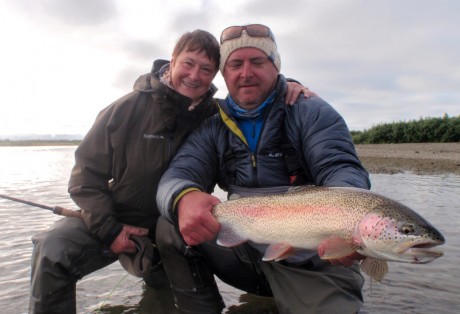
Yesterday marked the first official day of Autumn here in the northern hemisphere, and for many of us, that means streamer season. Fall spawning trout (brook and brown trout) are most territorial during this time, rainbow trout are on the prowl for large food items to fatten up for the long winter ahead, and as always, the biggest and baddest fish in the run is looking for a meal. Enter the streamer.
Streamer fishing is a super fun and effective way to target trout of all species. In Alaska, our streamers typically consist of sculpin, smolt, and leech patterns, but matching the particular baitfish or other forage in your waters can make the difference. Big flies, big takes, and big fish is what streamer fishing is all about, and we do a lot of it.
However, we’ve found that most anglers fish streamer patterns using only one technique before giving up on the streamer and reaching back for the nymphs. Every day, every river, and every run is different, and successful anglers know that changing up retrieves is key in fooling more trout. Here are 5 ways to fish a streamer more effectively.
- The Swing. Cast across and slightly down stream, make a mend, and the let the fly swing on through. The standard swing covers the most water effectively as possible. By slowly swinging the fly across the river or stream, you give the appearance of baitfish ferrying slowly across the river. Make sure to allow the fly to swing all the way through before retrieving the fly. Often times, a trout following a swung fly won’t hit until the first strip or two on the retrieve. After your fly line AND leader have straightened below you, make 4 or 5 honest strips back before considering your next cast.
- Banging the Banks. Casting a streamer to the opposite bank (or other likely holding lie) and immediately retrieving the fly with short quick strips is probably the most used technique. Why? Because it’s super effective! We call it banging the banks, and it can be done from a moving boat or from shore. The key is to cast into the first likely holding lie, make a few quality strips, then pick up the fly and hit the piece of juicy water. Covering water is the name of the game when banging the banks and by fishing each lie quickly, you key into the most aggressive fish.
- The Dead Drift. Dead drifting streamers is a highly neglected streamer technique. Baitfish, leeches, crayfish, or any other organism imitated by a streamer does become injured and/or dies from time to time, and a free tumbling fish is an easy meal for a hungry trout. Plunge pools, heavy current seams, or any other piece of water able to disorient a struggling minnow is a great place to dead drift a streamer.
- The Drift and Jig. The drift and jig is a great way to fish a streamer from shore that uses several techniques. Cast upstream as you would fish a dead drifting nymph. Continuously mend to allow your fly to get deep. As the fly drifts below you, make a series of quick lifts of the rod tip followed by a light slapping down of the fly line. Doing so creates a realistic jigging action imitating that of a struggling baitfish. Once the fly line becomes straight downstream, make a few quality strips back and repeat. Covering the water this way allows you to show your fly in three different forms; a dead fish (dead drift), and injured fish (the jig), and a fleeing fish (the strip) on one cast.
- The Jerk Strip. The jerk strip is a streamer technique that separates the novice fisherman from the seasoned streamer anglers. While a standard 6-8 inch strip will catch fish from time to time, it is not the most accurate imitation of a struggling baitfish or minnow. Instead, retrieve the fly using quick downstream twitches of the rod tip, followed by a slow strip of the line hand to take up the slack created by the ‘twitch.’ With a little practice, the movement of the rod tip with the rod hand, and the drawing in of fly line by the line hand becomes seamless, providing the most accurate retrieve possible. Give it a try!
Leave a Reply